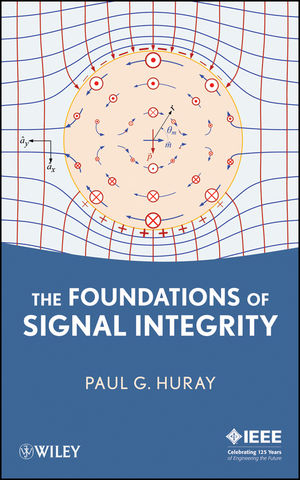
The Foundations of Signal Integrity
Wiley-IEEE Press (Verlag)
978-0-470-34360-9 (ISBN)
The first book to focus on the electromagnetic basis of signal integrity The Foundations of Signal Integrity is the first of its kind—a reference that examines the physical foundation of system integrity based on electromagnetic theory derived from Maxwell's Equations. Drawing upon the cutting-edge research of Professor Paul Huray's team of industrial engineers and graduate students, it develops the physical theory of wave propagation using methods of solid state and high-energy physics, mathematics, chemistry, and electrical engineering before addressing its application to modern high-speed systems. Coverage includes:
All the necessary electromagnetic theory needed for a complete understanding of signal integrity
Techniques for obtaining analytic solutions to Maxwell's Equations for ideal materials and boundary conditions
Plane electromagnetic waves
Plane waves in compound media
Transmission lines and waveguides
Ideal models vs. real-world systems
Complex permittivity of propagating media
Surface roughness
Advanced signal integrity
Signal integrity simulations
Problem sets for each chapter
With its thorough coverage of this relatively new discipline, the book serves as an ideal textbook for senior undergraduate and junior graduate students, as well as a resource for practicing engineers in this burgeoning field. At the end of each section, it typically stimulates the reader with open-ended questions that might lead to future theses or dissertation research.
Paul G. Huray, PhD, is Professor of Electrical Engineering at the University of South Carolina, where he has taught signal integrity, mathematical physics, and computer communications. Professor Huray introduced the first electromagnetics course to focus on signal integrity, and that program has produced more than eighty practicing signal integrity engineers now employed in academia, industry, and government. He earned his PhD in physics at the University of Tennessee in 1968, conducted research in the Solid State, Chemistry, and Physics Divisions at the Oak Ridge National Laboratory, and has worked part time for the Intel Corporation in developing the physical basis for barriers to circuits with bit rates up to 100 GHz.
Preface. Intent of the Book.
1. Plane Electromagnetic Waves.
Introduction.
1.1 Propagating Plane Waves.
1.2 Polarized Plane Waves.
1.3 Doppler Shift.
1.4 Plane Waves in a Lossy Medium.
1.5 Dispersion and Group Velocity.
1.6 Power and Energy Propagation.
1.7 Momentum Propagation.
Endnotes.
2. Plane Waves in Compound Media.
Introduction.
2.1 Plane Wave Propagating in a Material as It Orthogonally Interacts with a Second Material.
2.2 Electromagnetic Boundary Conditions.
2.3 Plane Wave Propagating in a Material as It Orthogonally Interacts with Two Boundaries.
2.4 Plane Wave Propagating in a Material as It Orthogonally Interacts with Multiple Boundaries.
2.5 Polarized Plane Waves Propagating in a Material as They Interact Obliquely with a Boundary.
2.6 Brewster's Law.
2.7 Applications of Snell's Law and Brewster’s Law.
Endnote.
3. Transmission Lines and Waveguides.
3.1 Infi nitely Long Transmission Lines.
3.2 Governing Equations.
3.3 Special Cases.
3.4 Power Transmission.
3.5 Finite Transmission Lines.
3.6 Harmonic Waves in Finite Transmission Lines.
3.7 Using AC Spice Models.
3.8 Transient Waves in Finite Transmission Lines.
4. Ideal Models vs Real-World Systems.
Introduction.
4.1 Ideal Transmission Lines.
4.2 Ideal Model Transmission Line Input and Output.
4.3 Real-World Transmission Lines.
4.4 Effects of Surface Roughness.
4.5 Effects of the Propagating Material.
4.6 Effects of Grain Boundaries.
4.7 Effects of Permeability.
4.8 Effects of Board Complexity.
4.9 Final Conclusions for an Ideal versus a Real-World Transmission Line.
Endnotes.
5. Complex Permittivity of Propagating Media.
Introduction.
5.1 Basic Mechanisms of the Propagating Material.
5.2 Permittivity of Permanent Polar Molecules.
5.3 Induced Dipole Moments.
5.4 Induced Dipole Response Function, G(τ).
5.5 Frequency Character of the Permittivity.
5.6 Kramers–Kronig Relations for Induced Moments.
5.7 Arbitrary Time Stimulus.
5.8 Conduction Electron Permittivity.
5.9 Conductivity Response Function.
5.10 Permittivity of Plasma Oscillations.
5.11 Permittivity Summary.
5.12 Empirical Permittivity.
5.13 Theory Applied to Empirical Permittivity.
5.14 Dispersion of a Signal Propagating through a Medium with Complex Permittivity.
Endnotes.
6. Surface Roughness.
Introduction.
6.1 Snowball Model for Surface Roughness.
6.2 Perfect Electric Conductors in Static Fields.
6.3 Spherical Conductors in Time-Varying Fields.
6.4 The Far-Field Region.
6.5 Electrodynamics in Good Conducting Spheres.
6.6 Spherical Coordinate Analysis.
6.7 Vector Helmholtz Equation Solutions.
6.8 Multipole Moment Analysis.
6.9 Scattering of Electromagnetic Waves.
6.10 Power Scattered and Absorbed by Good Conducting Spheres.
6.11 Applications of Fundamental Scattering.
Endnotes.
7. Advanced Signal Integrity.
Introduction.
7.1 Induced Surface Charges and Currents.
7.2 Reduced Magnetic Dipole Moment Due to Field Penetration.
7.3 Infl uence of a Surface Alloy Distribution.
7.4 Screening of Neighboring Snowballs and Form Factors.
7.5 Pulse Phase Delay and Signal Dispersion.
Chapter Conclusions.
Endnotes.
8. Signal Integrity Simulations.
Introduction.
8.1 Defi nition of Terms and Techniques.
8.2 Circuit Simulation.
8.3 Transient SPICE Simulation.
8.4 Emerging SPICE Simulation Methods.
8.5 Fast Convolution Analysis.
8.6 Quasi-Static Field Solvers.
8.7 Full-Wave 3-D FEM Field Solvers.
8.8 Conclusions.
Endnotes.
Bibliography.
Index.
| Reihe/Serie | IEEE Press |
|---|---|
| Sprache | englisch |
| Maße | 66 x 107 mm |
| Gewicht | 612 g |
| Themenwelt | Naturwissenschaften ► Physik / Astronomie ► Elektrodynamik |
| Technik ► Elektrotechnik / Energietechnik | |
| ISBN-10 | 0-470-34360-5 / 0470343605 |
| ISBN-13 | 978-0-470-34360-9 / 9780470343609 |
| Zustand | Neuware |
| Haben Sie eine Frage zum Produkt? |
aus dem Bereich


